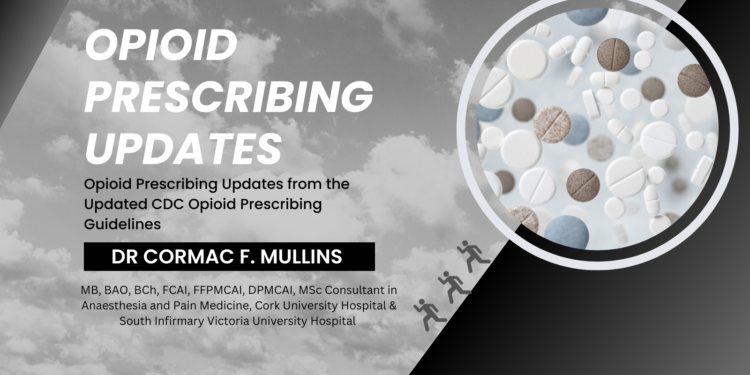Opioid Prescribing Updates from the Updates CDC Opioid Prescribing Guidelines.
Written by Dr Cormac F. Mullins, MB, BAO, BCh, FCAI, FFPMCAI, DPMCAI, MSc Consultant in Anaesthesia and Pain Medicine, Cork University Hospital and South Infirmary Victoria University Hospital drcormacmullins@gmail.com
A 45-year-old gentleman was admitted to hospital with a fractured tibial plateau following a road traffic collision. He was admitted under the orthopaedic team and placed on the emergency surgical theatre list. Due to a high volume of trauma patients admitted to the hospital, there were significant waiting times for access to theatre. The orthopaedic intern on the ward prescribed paracetamol and modified-release oxycodone 20mg twice daily, which was uptitrated to 30mg twice daily after three days. Later that week, he underwent operative fixation of the fracture. The anaesthetic team avoided regional anaesthesia due to the risk of compartment syndrome. His pain did not decrease in the expected manner post-operatively and this affected his engagement with physiotherapy. His modified-release oxycodone was uptitrated to 40mg twice daily. Due to substantial bed pressure that existed in the hospital, he was discharged on the third postoperative day with a script for analgesia and a follow-up appointment in the orthopaedic clinic in 6 weeks’ time. The discharging intern made sure he had sufficient analgesia to cover him for this period. When he presented to a busy orthopaedic clinic 6 weeks’ later, he remained on modified-release oxycodone. He requested that his script be refilled and this request was granted.
Opioid analgesics are highly effective in the management of acute severe pain. However, their use in a chronic setting is associated with an increased risk of opioid misuse, overdose and tolerance among other risks. A systematic review conducted by the Agency for Healthcare Research and Quality concluded that insufficient evidence existed for the long-term benefits of opioids in chronic pain.1 As higher doses are often required in order to maintain adequate analgesia, dose-related risks such opioid-induced respiratory depression, opioid-induced bowel dysfunction and dependence become more common. In addition, their use in the elderly comes with an increased risk of cognitive impairment and falls. Despite a lack of evidence for their benefit in chronic pain, their use has increased substantially in many developed countries, including in Ireland.2 Increased prescribing rates can lead to opioid-use disorder and opioid diversion, with many patients reporting not disposing of finished opioid prescriptions.
The 2016 Centers for Disease Control and Prevention (CDC) guideline for Prescribing Opioids for Chronic Pain was released to provide clinicians with a tool to assess the benefits and risks of opioid prescribing in chronic pain.3 Its introduction in the USA co-incided with rapid reductions in opioid dispensing rates per capita, with reductions in overall and high-risk prescribing, and increases in prescribing rates of nonopioids.4 Subsequent policies and legislation that arose out of this guideline, along with inflexible application of its recommendations, led to reports of overzealous tapering regimens, undertreated pain, acute withdrawals and accompanying psychological distress and unnecessary patient harm.5 These reports led to the development of a revised CDC opioid guideline in 2022 with a greater emphasis on patient-centred care, individualised care plans and flexibility.6
In addition to this, more recent evidence was included to support its prescribing recommendations in acute pain (<1 month duration) and subacute pain (1-3 months’ duration).
The new CDC guideline includes evidence from recent systematic reviews that non opioid medications are at least as effective as opioids for improving pain, function, or both, in many types of acute pain conditions, such as low back pain, neck pain, musculoskeletal conditions, minor surgery, dental procedures, headache or kidney stones. The guideline recommends that nonopioids are maximised where appropriate and where no contra-indication exists (e.g., oral or topical nonsteroidal anti-inflammatory medications). Nonopioids can include nonpharmacological interventions, such as exercise and psychological therapies, nonopioid medications, including serotonin and norepinephrine reuptake inhibitor (SNRI) antidepressants, pregabalin and gabapentin, nonsteroidal anti-inflammatory drugs (NSAIDs), and paracetamol. Nonopioid therapies are preferred in subacute pain and chronic pain. In moderate-to-severe pain where nonopioids are insufficiently effective or contra-indicated, opioids can provide a useful role. Like the previous guideline, the 2022 guideline recommends that opioids be prescribed at the lowest effective dose for no longer than the expected duration of severe pain. Unlike in the case above, patients should not be provided with extended scripts for opioid medication, especially for acute or subacute pain. Tapering should be instituted where opioids are used continuously for greater than a few days.
Both 2016 and 2022 CDC guidelines advise that when commencing opioids for subacute or chronic pain, an assessment should take place of the expected benefits, risks and goals of treatment. The goals of treatment can be considered in terms of reductions pain intensity and improvements in activities of daily life. If the agreed thresholds for treatment goals are not reached after a reasonable trial, or if the side effects exceed the benefits, then the trial should be considered unsuccessful and the opioid should be weaned and stopped. Unlike in the case above, when commencing opioids for acute, subacute, or chronic pain, immediate-release opioids should be prescribed instead of modified-release or long-acting preparations.6 Other speciality bodies have release statements and publications warning of the increased risks associated with long-acting opioids, including opioid-use disorder, prolonged hospital admission, respiratory depression, and death.7,8 Extended-release preparations were introduced into surgical practice in the mistaken belief that they provided superior pain relief and reduced nursing workload. Marketing campaigns promoted the idea of steady state plasma concentrations and a simple dosing schedule. However, the trajectory of acute pain and postoperative pain is typically one of the intermittent exacerbations of pain, especially associated with mobilisation, physiotherapy and exercise, which requires additional analgesia on an as required basis to facilitate such activity. Therefore, many patients require additional doses of immediate release opioids on top of their extended-release opioid, which can contribute to additional side effects and worse pain control.9 The FDA has advised that some extended release preparations should only be considered where patients have received a required dosage of an immediate-release preparation for at least one week.
“Where patients are already receiving opioids, the new guideline outlines how clinicians can work together with patients to determine whether opioids should be discontinued and how this can be done”
The new 2022 guideline specifically recommends that in cases of subacute opioid therapy (1 to 3 months), opioids should not be re-prescribed without carefully reassessing the goals, benefits and risks again, in order to prevent progression to unintentional long-term opioid therapy. This is illustrated in the case above. Frequently, opioids may be commenced in hospital and renewing the prescription may assumed by a different clinician, who may be unaware that the opioid was only commenced recently, and therefore, its continued use should be re-assessed. Furthermore, many patients do not get a benefit in pain reduction or improvement in function from increasing opioid doses to greater than 50mg Morphine Milligram Equivalents (MME) per day and are likely to lead to diminishing returns, but with a substantially increased risk of side effects.
Where patients are already receiving opioids, the new guideline outlines how clinicians can work together with patients to determine whether opioids should be discontinued and how this can be done. Again, the benefits and risks of continuing opioid therapy should be weighed against the benefits and risks of stopping opioids. The guideline emphasises the importance of patient centred care and shared decision-making especially as there may be reluctance or fear on the part of the patient to reduce their opioids. General principles are emphasised, rather than hard cut-offs, to avoid the application of inflexible standards that may be misapplied in certain circumstances. Tapering should be done slowly, especially where opioids have been used for a longer timeframe (e.g., ≥1 year), and reductions of approximately 10% per month should be better tolerated by patients than more rapid tapers. Patient motivation is optimal for successful tapers. Stopping opioid therapy after prolonged use can be very challenging and it is important that patients have effective support and do not feel abandoned. Clinicians should offer follow-up to patients at frequent intervals (ideally, at least monthly), and multidisciplinary input other team members including pharmacists and nursing is highly valuable. Tapers may have to be paused and recommenced if withdrawal symptoms appear or when the patient feels ready. Ideally, opioid tapering should be performed within the context of a multimodal and multidisciplinary approach to the patient’s pain management that is individualised and incorporates evidence-based treatment strategies and psychological support with the goal of improving patients’ function and quality of life, while minimising the risks of opioid therapy.
The central tenets of the updated CDC guidelines for opioid prescribing emphasise the importance of ensuring adequate access to effective pain management with an emphasis on improving function and quality of life, while minimising the risks associated with prescription opioid therapy. Communication between healthcare professionals and patients around the risks and benefits of opioids are central to ensuring patient-centred approaches to pain management and addressing the unique needs of every patient.
References available on request.











